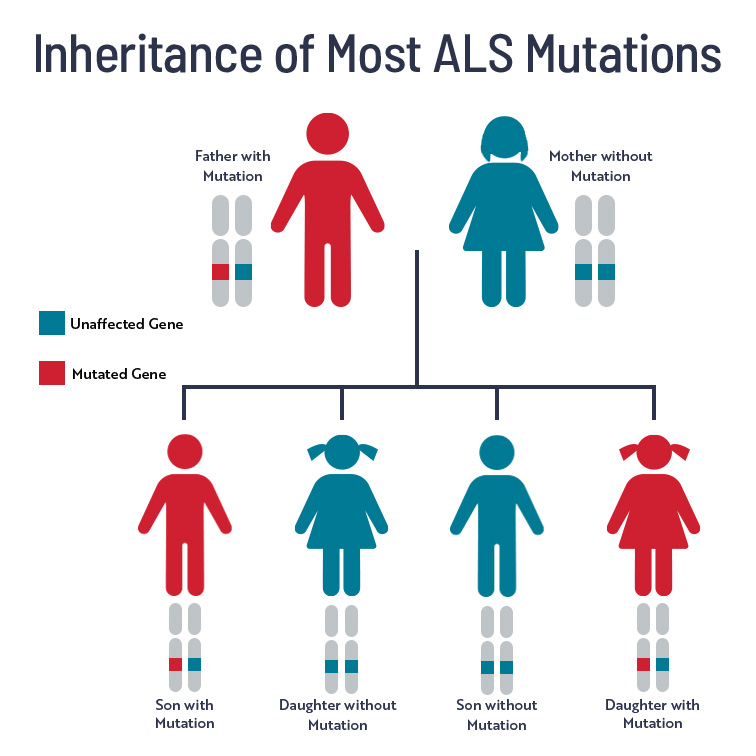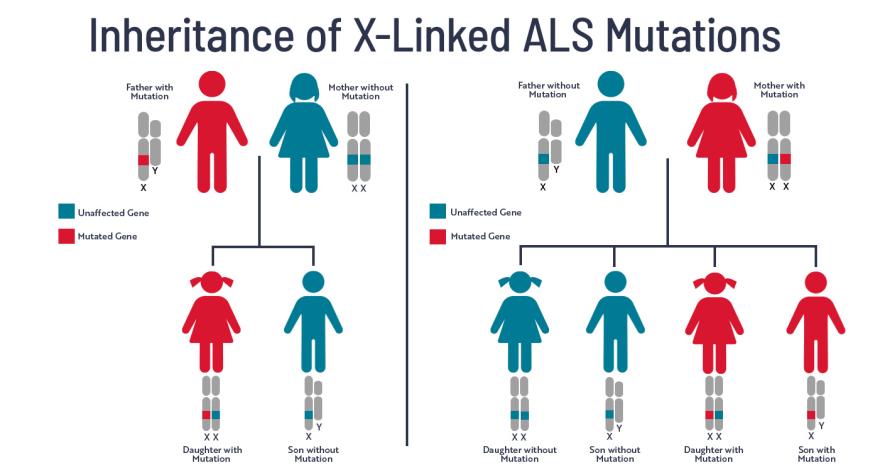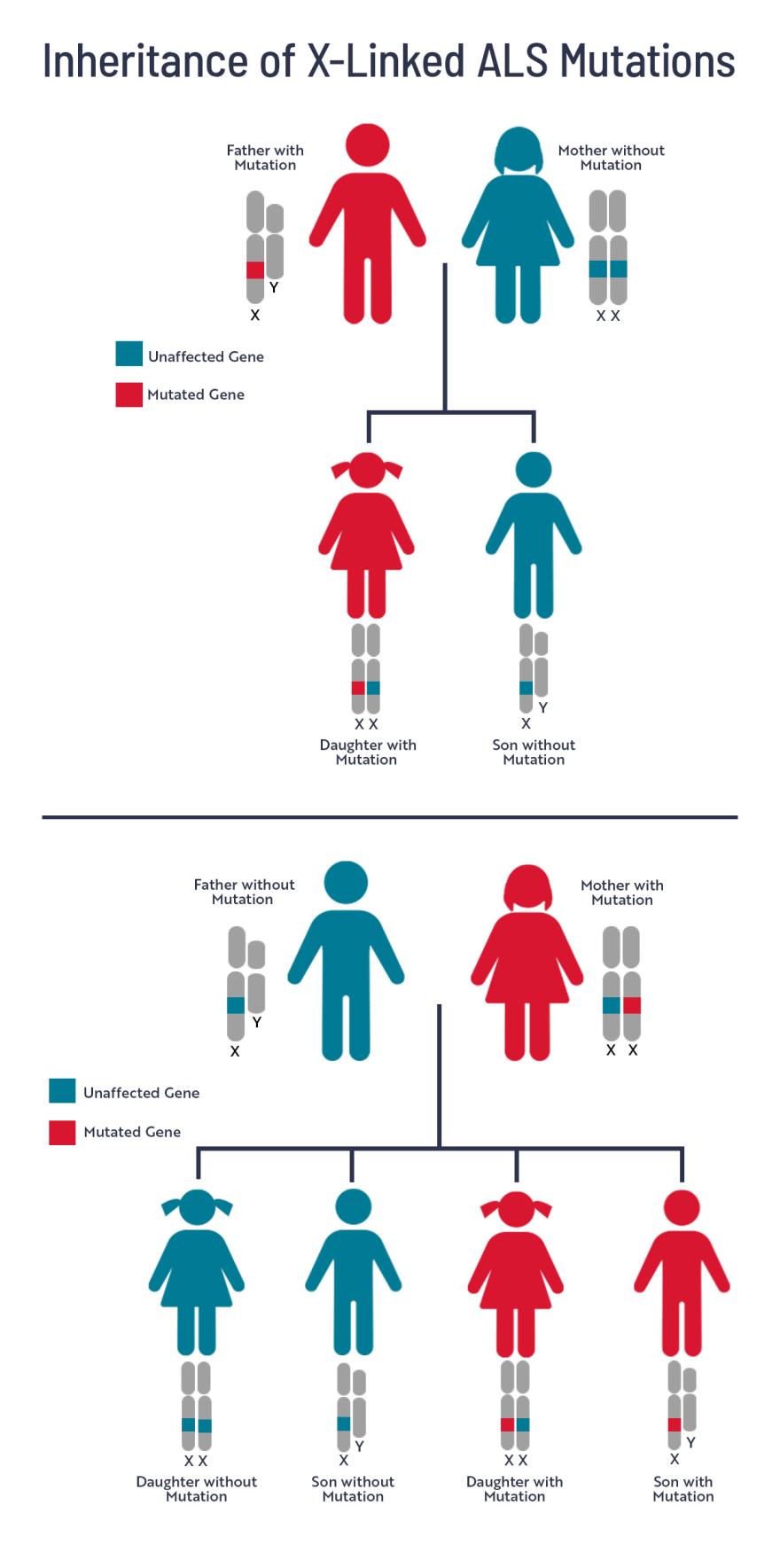ALS Inheritance
Because chromosomes occur in pairs, every cell (except sperm and eggs) has two copies of almost every gene. For instance, the C9orf72 gene, which has been linked to ALS, is located on chromosome 9. Since there are two copies of this chromosome, each cell carries two copies of the C9orf72 gene.
If at least one copy of the C9orf72 gene is mutated, it can lead to ALS. This is true for most ALS genes – inheriting one mutated copy is enough to cause or increase a person’s risk of developing the disease. When having just one copy of a mutated gene can cause disease, it is known as a dominant mutation. When both copies of a gene must be mutated to cause disease, it is called a recessive mutation.
Penetrance
Just because a person inherits an ALS-linked gene mutation does not automatically mean they will develop the disease. Penetrance refers to the likelihood that someone carrying a disease-causing mutation will go on to develop the disease.
Some gene mutations cause such a significant change in cell function that anyone who inherits it is highly likely to develop ALS at some point during their life. Examples of these include many of the mutations identified in the SOD1 and C9orf72 genes as well as other less common mutations. However, some ALS gene mutations are not as likely to cause the disease on their own, which means they have reduced (or incomplete) penetrance. These mutations increase a person's risk of the disease but may not cause it without other contributing factors.
The penetrance of most ALS gene mutations increases with age, so the likelihood of developing ALS generally increases as a person gets older. For example, the penetrance of the A4V mutation in SOD1, the most common SOD1 mutation in North America, is estimated to be at least 90% by age 70. This means that at least 90% of people with the A4V mutation develop ALS symptoms by age 70.
Probability, Chance and Genetic Inheritance
During the formation of eggs and sperm, chromosome pairs split up, so an egg or sperm each contains only one chromosome from each pair, incorporated at random. This means that a parent has a 50-50 chance of passing any specific gene along to their child.
Nearly all the ALS-associated genes that have been identified are located on autosomes, which are non-sex chromosomes (not the X and Y chromosomes). So, for example, if a man has one normal copy of the C9orf72 gene and one mutated copy, about half his sperm will contain the normal gene and the other half will contain the mutated gene. This means there is a 50% chance he will pass the mutated gene on to any of his children. The chances of passing it on to successive children are not affected by whether previous children received it; the chance is still 50% for each child. This would be the same for a woman carrying the mutation and passing it on in her eggs.

The same calculation holds true for almost all ALS genes. However, one ALS gene, UBQLN2, is found on the X chromosome, which changes the odds of inheritance since females inherit two X chromosomes and males inherit one X chromosome and one Y chromosome.
If the mother has a mutated UBQLN2 gene and the father does not, there is a 50% chance that any of her children will inherit a mutated copy. Fathers, on the other hand, cannot pass a mutated UBQLN2 gene on to their sons, but all their daughters will get a mutated copy.


Determining Your Genetic Status
The only way to know for sure if you carry a mutation in a gene associated with ALS is to get a genetic test. The decision whether to get tested or not is a very personal one. Genetic testing comes with many benefits, but also some risks, and may not be right for you. Click here to learn more about the benefits and risks of genetic testing for people currently living with ALS. If you haven’t been diagnosed with ALS but have family members with the disease, click here to explore the potential benefits and risks of genetic testing.
To learn more about ALS genetics, check out these resources provided by the International Alliance of ALS/MND Associations and watch this video from experts through our collaboration with the Alliance.
